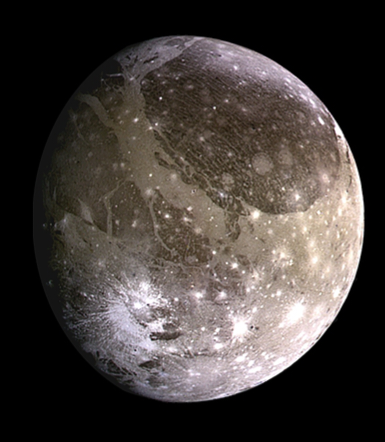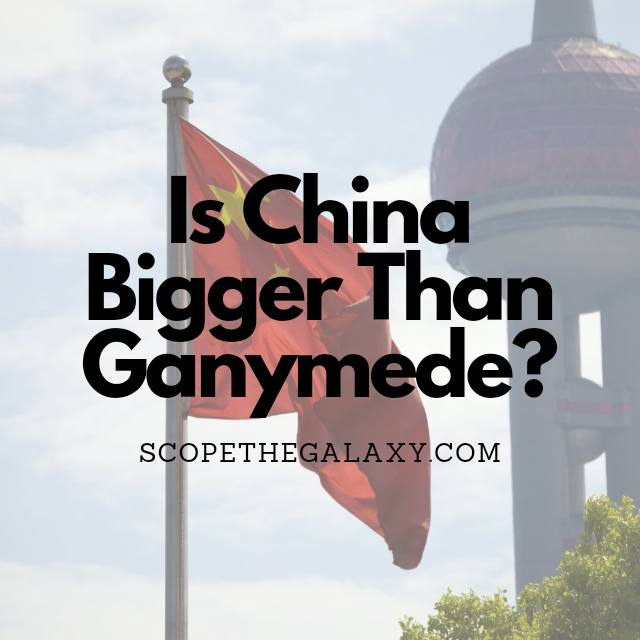*This post may contain affiliate links. This means we may make a commission if you purchase an item using one of our links*
China is the third largest country on Earth, while Ganymede is the largest moon in our Solar System. Ganymede has a surface area of 87.2 million sq. km while China’s is far lesser at 9.7 million sq. km. In regards to volume China’s is 462 million cubic km whereas Ganymede’s is 76.6 billion cubic km.
Continue reading to discover China’s diameter, surface area, and volume compared to the moon Ganymede. You’ll also learn some interesting facts about the two, along with their geographical composition.
How Big Is China?
Table of Contents

China – officially named the People’s Republic of China – is the third largest country in the world and is located in East Asia. It is also the most populous country in the world, with a population of over 1.4 billion people.
China has a land area of 9,388,211 sq. km and a total area of 9,706,961 sq. km. The total area comprises not only the land mass but also the bodies of water (such as lakes and rivers). China has a diameter of 5,000 km stretching from east to west and a north-south length of 5,500 km.
One-third of China’s total land area comprises mountains, and it is home to the tallest peak in the world, Everest, which occupies the border between China and Nepal. Thanks to this mountainous terrain, the average thickness of China’s continental crust is 47.6 km (the average global thickness is 39.2km). This gives China an estimated volume of 462,051,344 cubic km.
The topography of China is varied and encompasses the highest and one of the lowest places on Earth, with climates that vary from dry desert to tropical monsoon. In fact, China has the greatest north-south temperature contrast of any country in the world.
China’s coastline runs for around 14,000km, while its land frontier extends to 20,000km to encompass its borders with 14 other countries, including Russia, Mongolia, India, and Kazakhstan. Generally speaking, China has a high west side and a low east side, meaning that many of its rivers flow eastward.
The vast expanse of this country covers almost five time zones, but China operates under a single time zone to unify the country.
How Big Is Ganymede?


Ganymede is the largest moon of Jupiter and the largest object in our solar system not to be properly classified as a planet. It is the only moon with a magnetic field of its own, and one of the few bodies in our solar system known to possess a magnetosphere.
Ganymede has a diameter of 5,262 km and a surface area of 87,200,000 sq. km. Its diameter is similar to that of China, but its surface area is far vaster because the moon is spherical rather than flat. This gives it an impressive volume of 76,600,000,000 cubic km.
This moon is a source of fascination for scientists, with Hubble observations suggesting it may possess an underground ocean. Potentially, this ocean could contain more water than all the water on Earth combined with a depth of up to 100 km – ten times deeper than the oceans on Earth. This ocean is buried beneath a 150 km ice crust.
The terrain of Ganymede falls into two distinct categories: large, bright ridged regions and older, darker ground. This terrain pattern suggests the moon could have been under significant tension from global tectonic processes.
Galileo Galilei first discovered the moon in January 1610; significant because it was the first time scientists observed an object orbiting a planet other than Earth. And this helped us recognize that the Sun lies at the center of our Universe rather than the Earth.
Ganymede formed from leftover gas and dust that remained after Jupiter’s formation, which means that it is roughly the same age as our solar system – 4.5 billion years old.
Three main layers comprise Ganymede; a metallic core, a surrounding mantle of rock, and a top layer of ice. Computer models simulating Ganymede’s makeup show that more ice and oceans could be sandwiched between these main layers. The Hubble Space Telescope also discovered that the moon might have a thin atmosphere of oxygen.
Ganymede is the seventh moon from Jupiter, which orbits at around 1.070 million kilometers away from its planet. This means that Ganymede takes roughly seven Earth days to orbit its planet. While Ganymede is vast – larger than the planet Mercury – it only possesses half the mass of our closest planet to the Sun, classifying it as a low-density object.
Summary
China has a diameter comparable to that of Ganymede; its east-west diameter is slightly shorter, and its north-south is slightly longer. Still, once we compare the surface area and volume of the two bodies, we see that Ganymede is far more vast, thanks to its composition as a three-dimensional object.
References
China – The Sichuan Basin | Britannica
Largest Countries in the World by Area – Worldometer (worldometers.info)
Ganymede (moon) – Wikipedia
In Depth | Ganymede – NASA Solar System Exploration

